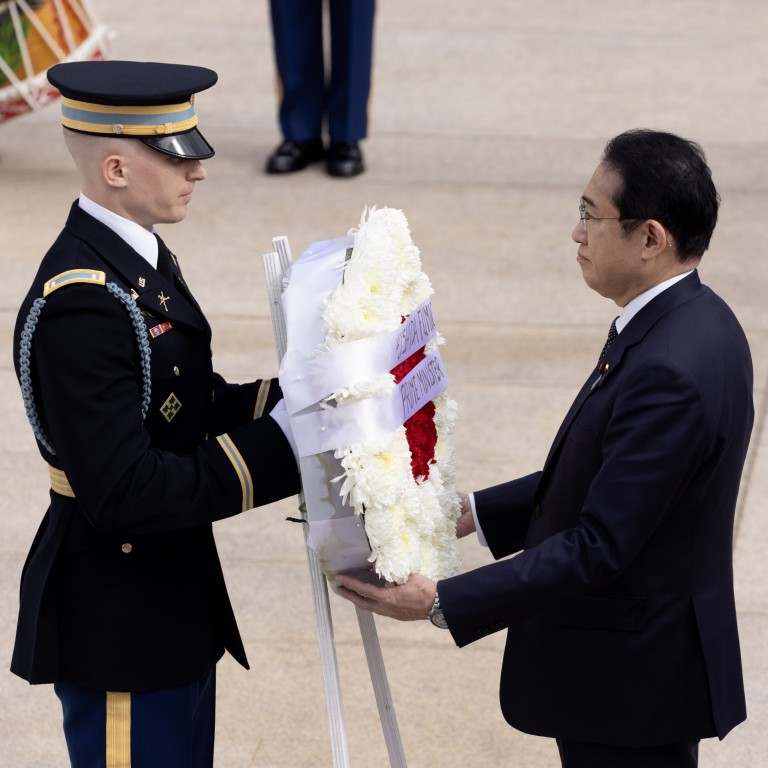
US-Japan summit preview: Joe Biden and Fumio Kishida expected to raise defence, diplomacy as China looms
- Joined by the Philippine president, leaders will showcase ‘support and solidarity’ for common vision of South China Sea, White House official says
- US ambassador to Japan describes Tokyo as pivotal in ‘latticework’ strategy, but analysts say much remains politically vulnerable
“We are continuing to innovate the groupings with whom we’re working closely, adding to the fit-for-purpose latticework that we are using throughout the Indo-Pacific,” she added.

“Our two countries are working together with a clearer understanding of the importance of closer coordination … as we establish that joint operational command,” said Shigeo Yamada, Japan’s ambassador to the US, at the Centre for Strategic and International Studies, a Washington think tank.
The two leaders were “basically on the same page”, Yamada added.
That page, however, is unlikely to include much detail any time soon, as the allies struggle to reorganise entrenched defence systems built over decades.
‘A message for China’: US’ new missile launchers in Asia a ‘warning’ to Beijing
Tokyo is pushing for Japan to play a more prominent role, pointing to the confusion and turf battles that could ensue were a conflict to erupt.
The allies are also likely to discuss bolstered air-power cooperation, co-production of defence equipment and defence industrial policy coordination, said CSIS analyst Christopher Johnstone.
While economics are not expected to dominate bilateral discussions, the Biden administration’s decision, announced before the summit, to block Nippon Steel’s US$41 billion takeover bid for US Steel on national-security grounds has added friction.

“All deliverables are likely to have a security component, and they’ll underplay Nippon Steel,” said Jeremy Chan, a geopolitical analyst with the Eurasia Group. “That’s such an ill-timed, tin-eared move.”
Rahm Emanuel, US ambassador to Japan and a Chicago native and former mayor, countered on Monday that too much has been made of the Nippon Steel decision given growing bilateral ties. “As we would say in Chicago, ‘you gotta chill’.”
The US-Japan summit will include one-on-one talks, a joint press conference, a state dinner, a speech before the US Congress and meetings between Kishida and Japanese companies in North Carolina. The trilateral leaders’ summit on Thursday will include talks and a three-way press conference.
The administration’s “latticework” system meant to deter China encompasses a variety of initiatives targeting the Indo-Pacific region.
China ‘gravely concerned’ about reports Japan could join Aukus security pact
“We also face the reality that China is increasing its presence in the region,” Kishida said in Tokyo before his arrival, adding that other Asian countries like the Philippines expected “Japan to increase its presence and provide an attractive alternative”.
China’s foreign ministry on Monday said any defence cooperation should promote regional peace. “We oppose cobbling together exclusive groupings and stoking bloc confrontation in the region,” added ministry spokeswoman Mao Ning.
PLA patrols South China Sea as US, Philippines, Japan and Australia hold drills
In taking a leading role in many regional “mini-lateral” arrangements, Tokyo has reversed a decades-long record of cautious defence and diplomatic policies.
Japan recently announced it would double its 2022 defence budget by 2027, add counterstrike capability, lift its cap on defence exports and stabilise historically prickly relations with Seoul.
“There’s been a strategic rethinking about how great the risks were in the region and how implicated Japan is in any contingency,” said Chan. “They can’t avoid being involved, so they might as well lean in.”
“My sense is that there is not yet a consensus among the three Aukus partners on what that project is,” Johnstone said.

Kishida hopes to deepen security cooperation in such areas as defence equipment and technology.
Bingen further expected greater collaboration in missile warning, hypersonic weapons, satellite architectures and data sharing.
Even as Japan takes a more forceful posture in the South China Sea, South Korea is likely to hang back despite its new trilateral pact with Washington and Tokyo, analysts said, in view of its economic dependence on China. Nor is Pyongyang likely to be a particular focus of this week’s meetings.
“I’m not expecting any sort of [North Korea-] specific announcements to come out tomorrow,” said Rapp-Hooper. “But we are excited about continuing to further the progress that we make on regional missile defence integration more broadly.”
Biden and Kishida to announce ‘historic’ US-Japan agreement: envoy
“The leaders of all three countries are now seeking to quickly institutionalise a new coordinated approach to regional security,” said Haroro Ingram, Philippines country representative with the non-profit United States Institute of Peace.
“But the Marcos administration correctly recognises that it cannot solely rely on its two closest friends to deal with the challenges of the next decade.”
In recent years, Tokyo has provided defence aid, patrol boats and radar systems to Manila as the two sides negotiate an agreement to train troops in each other’s country.
“Our alliance with Japan is fundamental,” said Republican senator Mitt Romney of Utah, who chairs a Senate subcommittee on East Asia.
“At a time of growing military aggression by China in the Taiwan Strait and the South China Sea, the United States must remain committed to strengthening diplomatic ties and security cooperation.”
How will China react as Biden readies for ‘Camp David’ with Kishida, Marcos?
But officials and analysts acknowledged that much of the material making up the latticework was politically vulnerable.
“Springtime may see a blossoming US-Japan alliance,” said Mireya Solis, a Brookings Institution senior fellow. “But cooperative endeavours will be tested by the winds of political change come fall.”
Emanuel said there was no denying some short-term exposure.
“Roots are being put down,” he said. “But it’s early enough that unless you’re building on it constantly, it will atrophy. And we all know that.”


